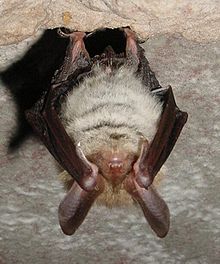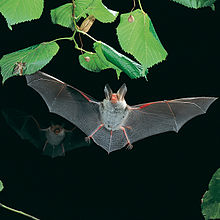- Bechstein's Bat
-
Bechstein's Bat 
Conservation status Scientific classification Kingdom: Animalia Phylum: Chordata Class: Mammalia Order: Chiroptera Family: Vespertilionidae Genus: Myotis Species: M. bechsteinii Binomial name Myotis bechsteinii
Kuhl, 1817
Bechstein's Bat (Myotis bechsteinii) is a species of vesper bat in the Vespertilionidae family. It can be found in the following countries: Austria, Armenia, Belarus, Belgium, Bosnia and Herzegovina, Bulgaria, Croatia, Czech Republic, France, Georgia, Germany, Hungary, Iran, Italy, Liechtenstein, Republic of Macedonia, Moldova, Montenegro, Netherlands, Poland, Portugal, Romania, Russian Federation, Serbia, Slovakia, Slovenia, Spain, Sweden, Switzerland, Turkey, Ukraine, United Kingdom and Iran.[1]
Contents
Habitat
It will both roost and forage in suitable woodland of at least 25 hectares in size and only rarely venture outside of them.
In the United Kingdom Bechstein's Bats are most commonly found in the Forest of Dean and Herefordshire, however a single male was caught and recorded near Colby in Southern Pembrokeshire. The UK distribution has been plotted on the National Biodiversity Network website and can be found here.
They frequently roost in old Woodpecker holes, oak and Ash seeming to be the most important to the species.
Protection
They are protected under the European Habitats Directive. In the UK their rarity means that Woodlands containing the species may be considered for notification as a Site of Special Scientific Interest and may attract a grant under Natural Englands Environmental Stewardship scheme.
Echolocation
The frequencies used by this bat species for echolocation lie between 35–108 kHz. Its echolocation calls have the most energy at 61 kHz and have an average duration of 3.3 ms.[2][3]
References
- ^ Chiroptera Specialist Group 1996. Myotis bechsteini. 2006 IUCN Red List of Threatened Species. Accessed on 09 July 2007.
- ^ Parsons, S. and Jones, G. (2000) 'Acoustic identification of twelve species of echolocating bat by discriminant function analysis and artificial neural networks.' J Exp Biol., 203: 2641-2656.
- ^ Obrist, M.K., Boesch, R. and Flückiger, P.F. (2004) 'Variability in echolocation call design of 26 Swiss bat species: Consequences, limits and options for automated field identification with a synergic pattern recognition approach.' Mammalia., 68 (4): 307-32.
Categories:- IUCN Red List vulnerable species
- Mammals of Gibraltar
- Mammals of Spain
- Mammals of Portugal
- Mammals of Andorra
- Mammals of France
- Mammals of Monaco
- Mammals of the United Kingdom
- Mammals of Belgium
- Mammals of the Netherlands
- Mammals of Luxembourg
- Mammals of Denmark
- Mammals of Germany
- Mammals of Switzerland
- Mammals of Liechtenstein
- Mammals of Austria
- Mammals of Italy
- Mammals of Croatia
- Mammals of Bosnia and Herzegovina
- Mammals of Serbia
- Mammals of Montenegro
- Mammals of the Republic of Macedonia
- Mammals of Greece
- Mammals of Hungary
- Mammals of Turkey
- Mammals of Iran
- Mammals of Azerbaijan
- Mammals of Armenia
- Mammals of Georgia (country)
- Mammals of Russia
- Mammals of Ukraine
- Mammals of Belarus
- Mammals of Poland
- Mammals of the Czech Republic
- Mammals of Slovakia
- Mammals of Bulgaria
- Mammals of Romania
- Mammals of Moldova
- Mouse-eared bats
- Mammals of Great Britain
Wikimedia Foundation. 2010.


